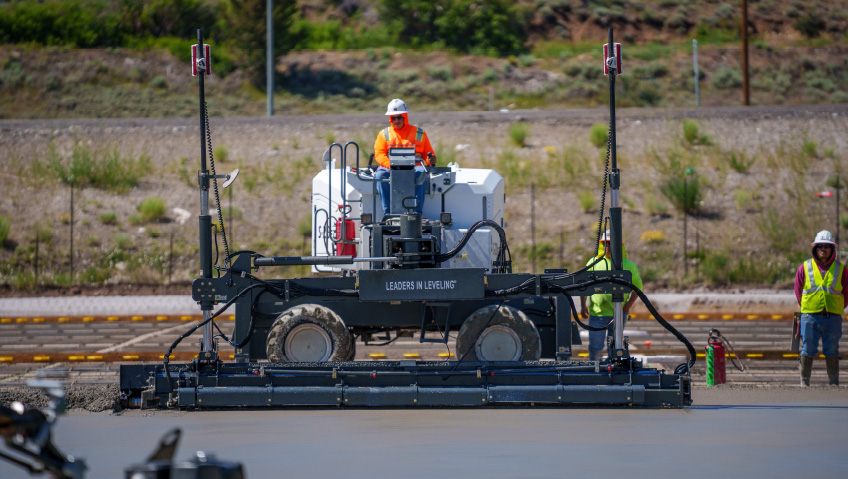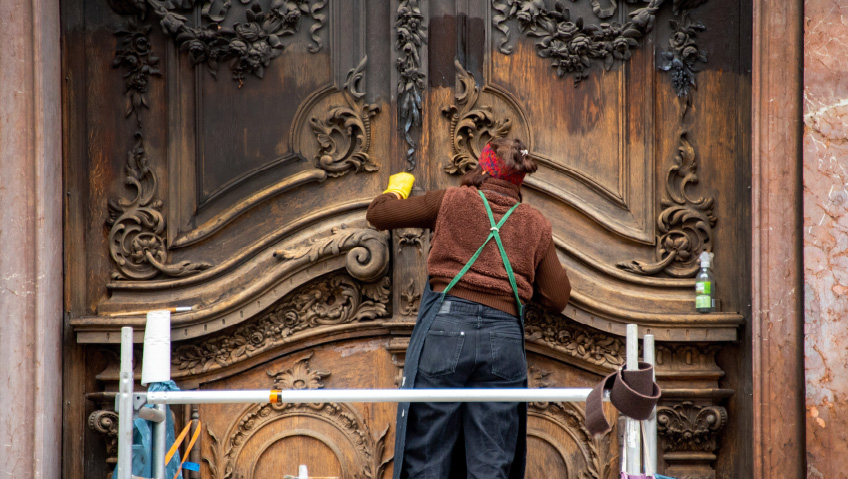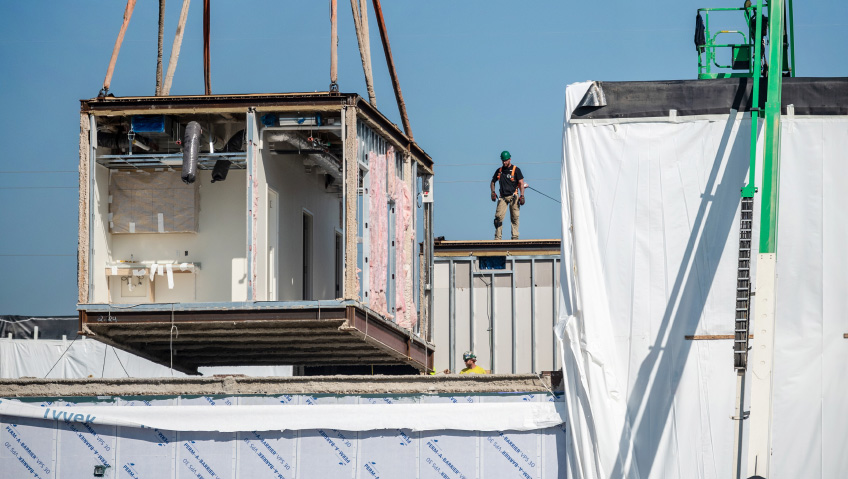Greg Tedesco began laying the foundation for his success in the concrete industry in 1978, when he cemented his career in California’s ready-mix sector before transitioning into slip-form contracting and residential concrete. After establishing Tedesco Construction in Reno, Nevada in 1984, Greg’s company branched out into transportation and concrete pumping in 2000 as Tedesco Pacific Construction, Inc., which became a market leader in 2007 after refocusing on its core competencies: tilt-up and cast-in-place concrete projects completed on schedule and within budget.
With a seasoned and trustworthy staff led by Greg, his wife Lora Tedesco, and President Tom Mourning, Tedesco Pacific Construction takes pride in having a devoted workforce of motivated, well-trained, and safety-conscious foremen and employees.
A concrete forming and finishing contractor that specializes in multi-level slab-on-deck projects and high-performance floors for large industrial projects, Tedesco boasts expertise in design-build tilt-up/cast-in-place, superflat F-number floors, specialty structural slabs and foundations, high square footage structures, multi-story residential and parking structures, and industrial, distribution, and business park projects. Tedesco is also certified by the FACE Company in F-numbers, a metric for flatness and levelness.
“Greg Tedesco founded Tedesco Construction in the ’80s, and he moved from residential curb and gutter in the ’90s into commercial work,” says Mourning. “I came on in the late ’90s to do all the tilt-up and commercial work as a project manager. After that, during the 2000s, the tilt-up market exploded, and we went from a company of 60 to 300 employees, until the economy eventually turned and we went back down. We rebuilt after that to where we are today.”
Looking to grow further, Tedesco has expanded into fresh markets. “Our models transitioned, mainly due to market demand, from tilt-ups and large commercial work to data center work primarily,” largely in northern Nevada.
“The state has really set itself up to be one of the main hosting sites for a lot of the big AI push,” says owner Nathan Esch. “It started a little bit before AI became a thing, with some data centers popping up just for general hosting services for companies. But the computing needs that AI is going to demand will require a lot more data centers, so that’s what everybody’s building right now.”
Tedesco began work on data centers at Apple’s campus about 10 years ago, adds Mourning. “Now the campus has become the hot and heavy data center park,” he says. “There are millions of feet of industrial space, and the data center work there is going to be probably 15 campuses, with each campus having 10-plus buildings.”
Unfortunately, a lot of the data centers—owing to how they’re built, their seismic and load requirements, and site constraints—are not conducive to tilt-up construction, Mourning explains. So those have become precast, or what are called insulated metal panels (IMPs), which are pre-built panels that stand on the exterior skin of the building.
“The original demand for tilt work, and one of the great things about it, was the speed and efficiencies with which you could build these big warehouses,” Mourning adds. This meant 50,000-foot slab pours followed by a number of panel pours at a time. Then, the exterior of the building, which is a lot of the structure, could be stood up within four days after being out there for six or seven weeks, whereas a steel structure building would typically take a longer amount of time to do the same size building.
Tilt-up is still working on making its name known. Fairly popular on the West Coast for some time now, it still struggles to find its footing on the East Coast. Chicago and the central United States is still more of a precast region.
“One of the big pushes into tilt-up came out of the shift from brick-and-mortar retail to e-commerce,” adds Esch. “You didn’t have as much storefront to store inventory, plus you needed delivery and last-mile infrastructure, so that drove a lot of the tilt-up growth in the early 2000s.”
“Nobody needs a storefront anymore,” Mourning agrees. “They just have a website and then a storage facility to transfer millions of pieces of inventory every single day.” A number of big box chains also adopted tilt-up building methods, largely because of the time saved in their construction.
While many of Tedesco’s upcoming projects are under tight wraps, there are numerous highly sophisticated data center projects in the works in the Tahoe-Reno Industrial Center. The owners and developers of these projects are looking for more carbon-sensitive solutions in their data center facilities. Sustainability is becoming a bigger concern in all areas of building services, and owners and developers in general are looking to go green wherever possible. In many of these projects, where there are tens of thousands of yards of concrete in each building, it is possible to reduce their carbon footprint by including recycled concrete materials in the concrete itself.
“This has resulted in upwards of 35 percent of all the concrete materials and cement and cementitious materials placed on the jobs being low-carbon or recycled materials,” Mourning shares.
Paramount to much of Tedesco’s success is its dedicated staff and a low turnover rate across the board—carpenters, foremen, finishers, superintendents, and office staff. “We run a pretty tight ship in terms of how many employees we actually use on the jobs and in the office,” says Mourning. “The production is high, and turnover is low. Everybody has a good idea of what they’re doing and how they’re doing it, producing a good product in and out of the field.”
Mourning is being “pretty modest,” adds Esch: Tedesco’s average tenure for employees is over 20 years. “It’s a very tight-knit group that works very well together, and that’s a testament to Tom and his team, making sure they keep everybody fully employed and able to get work,” he says. This also means ensuring employees are fairly compensated and are happy doing what they do. It’s always been important for the leadership that as the company does better, the employees get to share in that success and put money away for their retirement.
“They have taken excellent care of their tradesmen over time,” says Esch. “When you go to a Tedesco site, it’s like the concrete version of poetry. Everybody knows what they’re doing. It’s a very quiet job site. Nobody is panicking. It’s a very impressive thing. I’ve never seen anything like it.”
The company has even transitioned to using no temp employees at all. “We have enough employees to staff the jobs and staff them with the right people, keeping everybody moving in the right direction,” says Mourning.
It is, however, still a challenge to find skilled tradespeople, adds Esch. “But when you have a good culture and a good reputation, the right people come through the door.”
The biggest challenge is assessing how the economy is going to affect the company’s future workload. “Even with the data center work—unless somebody pulls the plug on AI—it’s going to keep moving forward,” Mourning says. “But in terms of tilt work, the challenge is that everybody’s overbuilt to the extent where there’s probably a surplus of 20 percent of the warehouses out there that are vacant.”
Vacancy rates have definitely picked up, adds Esch. “You’ve also got capitalization rates going down recently. Everybody was used to a low-interest rate environment, and that’s obviously changed, putting a lot of pressure. General labor shortages throughout the whole supply chain have increased prices dramatically over the last five years.” Tariffs, of course, are also top of companies’ minds these days, now that much of the rebar and steel is fabricated offshore, while demand for cement has decreased to the point where none of it is being imported.
Even as the economy fluctuates, Tedesco aims to stay at the top of the marketplace as it moves forward, and the company’s dedication to quality work and customer service has resulted in multiple Golden Trowel® Awards, presented by Face® Construction Technologies, honoring the floor slabs that were the flattest and most level the world over.
“Our quality is a big part of who we are,” says Mourning, “staying on top of that and making sure we’re not missing a step and our work comes out as promised. We pride ourselves on doing a project where there are no callbacks and the customers received what they asked for or better than what they asked for.”
Success, he believes, all comes back to quality and Tedesco’s impressive history of employee retention. The company has proven its ability to evolve without losing sight of craftsmanship or culture. With a loyal, experienced team, a focus on sustainable practices, and an eye on emerging markets, Tedesco Pacific Construction continues to pour the foundation for a bright future, one expertly finished project at a time.






